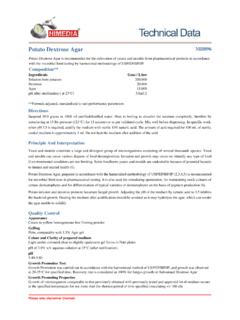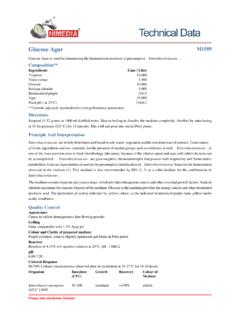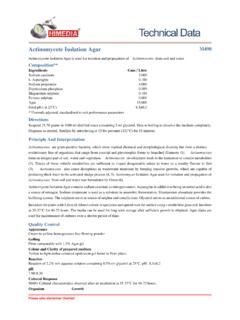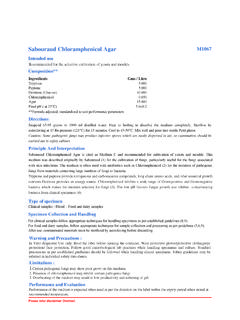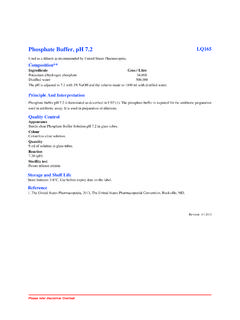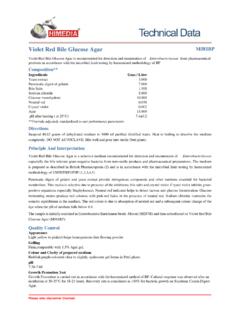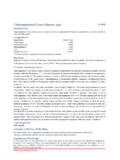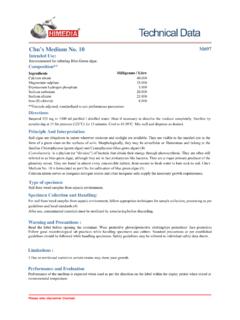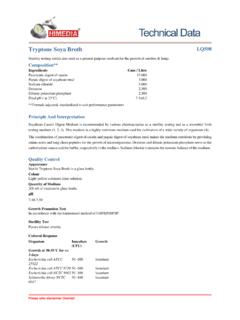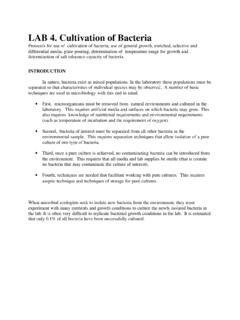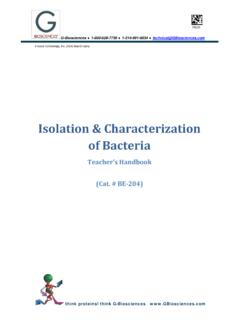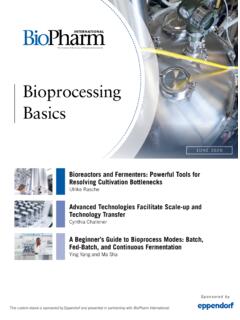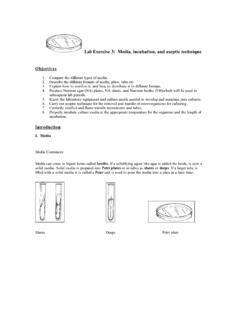Transcription of Nutrient Agar - himedialabs.com
1 Please refer disclaimer AgarM001 Intended useNutrient agar is used as a general purpose medium for the cultivation of less fastidious microorganisms, can be enriched with blood or other biological **IngredientsGms / peptone B# pH ( at 25 C) **Formula adjusted, standardized to suit performance parametersDirectionsSuspend grams in 1000 ml purified / distilled water. Heat to boiling to dissolve the medium completely. Sterilize by autoclaving at 15 lbs pressure (121 C) for 15 minutes. Cool to 45-50 C. If desired ,the medium can be enriched with 5-10% blood or other biological fluids. Mix well and pour into sterile Petri And InterpretationNutrient media are basic culture media used for maintaining microorganisms, cultivating fastidious organisms by enriching with serum or blood and are also used for purity checking prior to biochemical or serological testing (5,6).
2 Nutrient agar is ideal for demonstration and teaching purposes where a more prolonged survival of cultures at ambient temperature is often required without risk of overgrowth that can occur with more nutritious substrate. This relatively simple formula has been retained and is still widely used in the microbiological examination of variety of materials and is also recommended by standard methods. It is one of the several non-selective media useful in routine cultivation of microorganisms (1,7). It can be used for the cultivation and enumeration of bacteria which are not particularly fastidious. Addition of different biological fluids such as horse or sheep blood, serum, egg yolk etc.
3 Makes it suitable for the cultivation of related fastidious organisms. Peptone, HM peptone B and yeast extract provide the necessary nitrogen compounds, carbon, vitamins and also some trace ingredients necessary for the growth of bacteria. Sodium chloride maintains the osmotic equilibrium of the medium.# - Equivalent to Beef extract Type of specimen Clinical samples - Blood; Food and dairy samples; Water samplesFor clinical samples follow appropriate techniques for handling specimens as per established guidelines (3,4). For food and dairy samples, follow appropriate techniques for sample collection and processing as per guidelines (1,7,8). For water samples, follow appropriate techniques for sample collection, processing as per guidelines and local standards.
4 (2) After use, contaminated materials must be sterilized by autoclaving before discarding. Specimen Collection and Handling: Warning and Precautions :In Vitro diagnostic use. Read the label before opening the container. Wear protective gloves/protective clothing/eye protection/ face protection. Follow good microbiological lab practices while handling specimens and culture. Standard precautions as per established guidelines should be followed while handling clinical specimens. Safety guidelines may be referred in individual safety data organisms differ in their growth requirement and may show variable growth patterns on the LaboratoriesTechnical DataStorage and Shelf LifeStore between 10-30 C in a tightly closed container and the prepared medium at 20-30 C.
5 Use before expiry date on the label. On opening, product should be properly stored dry, after tightly capping the bottle in order to prevent lump formation due to the hygroscopic nature of the product. Improper storage of the product may lead to lump formation. Store in dry ventilated area protected from extremes of temperature and sources of ignition. Seal the container tightly after use. Use before expiry date on the performance is best if used within stated expiry period. Colour and Clarity of prepared mediumLight yellow coloured clear to slightly opalescent gel forms in Petri platesReactionReaction of w/v aqueous solution at 25 C. pH : ResponseCultural characteristics observed after an incubation at 35-37 C for 18-48 (CFU)GrowthRecoveryQuality ControlAppearanceCream to yellow homogeneous free flowing powderGellingFirm, comparable with agar gelPerformance and EvaluationPerformance of the medium is expected when used as per the direction on the label within the expiry period when stored at recommended must ensure safe disposal by autoclaving and/or incineration of used or unusable preparations of this product.
6 Follow established laboratory procedures in disposing of infectious materials and material that comes into contact with clinical sample must be decontaminated and disposed of in accordance with current laboratory techniques (3,4). DisposalPlease refer disclaimer coli ATCC 25922 (00013*)50-100 Pseudomonas aeruginosa ATCC 27853 (00025*)50-100 Salmonella Typhi ATCC653950-100 Staphylococcus aureus subsp. aureus ATCC 25923 (00034*)50-100 Streptococcus pyogenes ATCC 1961550-100good-luxuriant >=70%good-luxuriant >=70%good-luxuriant >=70%good-luxuriant >=70%Salmonella Enteritidis ATCC 13076 (00030*)50-100 Salmonella Typhimurium ATCC 14028 (00031*)50-100 Yersinia enterocolitica ATCC 9610 (00038*)50-100 Yersinia enterocolitica ATCC 23715 (00160*)50-100good-luxuriant >=70%good-luxuriant >=70%good-luxuriant >=70%good-luxuriant >=70%good-luxuriant >=70%Key : *Corresponding WDCM lot of the medium has been tested for the organisms specified on the COA.
7 It is recommended to users to validate the medium for any specific microorganism other than mentioned in the COA based on the user s unique LaboratoriesTechnical DataDisclaimer :User must ensure suitability of the product(s) in their application prior to use. Products conform solely to the information contained inthis and other related HiMedia publications. The information contained in this publication is based on our research and developmentwork and is to the best of our knowledge true and accurate. HiMedia Laboratories Pvt Ltd reserves the right to make changes tospecifications and information related to the products at any time.
8 Products are not intended for human or animal or therapeutic use butfor laboratory,diagnostic, research or further manufacturing use only, unless otherwise specified. Statements contained herein should notbe considered as a warranty of any kind, expressed or implied, and no liability is accepted for infringement of any : 05 / 2021In vitro diagnostic medical device CE MarkingDo not use if package is damagedCE Partner 4U ,Esdoornlaan 13, 3951 DB Maarn The Netherlands, IVDS torage temperature10 C30 CEC REPHiMedia Laboratories Pvt. Limited, 23 Vadhani Industrial Estate, LBS Marg,Mumbai-86,MS,India HiMedia Laboratories Pvt. Ltd. : 23, Vadhani , LBS Marg, Mumbai-400086, India.
9 Customer care No.: 022-6116 9797 Corporate office : A-516,Swastik Disha Business Park,Via Vadhani Ind. Est., LBS Marg, Mumbai-400086, India. Customer care No.: 022-6147 1919 Email: Website: Public Health Association, Standard Methods for the Examination of Dairy Products, 1978, 14th Ed.,Washington Baird , Eaton , and Rice , (Eds.), 2015, Standard Methods for the Examination of Water and Wastewater,23rd ed., APHA, Washington, Isenberg, Clinical Microbiology Procedures Handbook 2nd Jorgensen, , Pfaller, , Carroll, , Funke, G., Landry, , Richter, and Warnock., (2015) Manualof Clinical Microbiology, 11th Edition.
10 Vol. Lapage S., Shelton J. and Mitchell T., 1970, Methods in Microbiology', Norris J. and Ribbons D., (Eds.), Vol. 3A,Academic Press, MacFaddin J. F., 2000, Biochemical Tests for Identification of Medical Bacteria, 3rd Ed., Lippincott, Williams andWilkins, Y., and Tortorello , 2015, Compendium of Methods for the Microbiological Examination of Foods, 5thEd., American Public Health Association, Washington, Wehr H. M. and Frank J. H., 2004, Standard Methods for the Microbiological Examination of Dairy Products, 17thEd.,APHA Inc., Washington.
